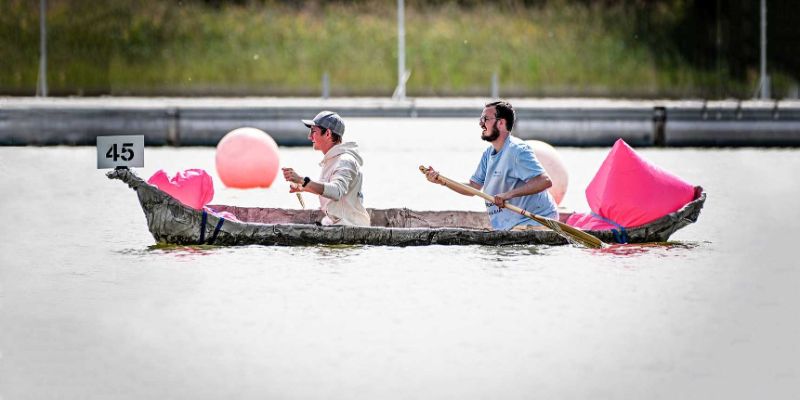Sustainable solutions from a concrete canoe
Roland Brunschweiler and Pascal Minder spent an entire semester working on and tinkering with the ideal material mix for their concrete canoe "TruchETH" as part of their bachelor's degree thesis. Yesterday, their four-meter, 90-kilogram vessel was finally loaded for transport to Brandenburg an der Havel, along with the willow canoe from the concrete canoe club at ETH Zurich. At the regatta, 79 teams of students from 32 institutions all over Europe compete against each other. The teams will be evaluated not only on the speed with which they complete the course but also on the design and construction of the canoe.
In the past, the Zurich teams have regularly received top marks, especially in the construction category. This year, their goal is to win the sustainability award. What makes "TruchETH" special is its reinforcement, which is made entirely of recycled clothing. For this, Brunschweiler and Minder cut used jeans and t-shirts into strips of fabric and wove them together. The resulting mesh functions similarly to a fiberglass fabric and absorbs the variable forces that occur. The textile mesh was then coated with several layers of "concrete" based on environmentally friendly cement and vegetable charcoal. These natural additives serve to sequester the emitted carbon dioxide by storing it inside the concrete.
Cycle of waste
"When you hear of a canoe made of fabric and concrete, sustainability might not immediately come to mind," says Bachelor student Pascal Minder. "But sustainability, like waste, has many faces." The two students were shaken by a report on Swiss television that documented how Western countries send nearly unimaginable quantities of old clothes to developing countries every year. Although these textiles are intended as donations, most cannot be used and frequently end up in the sea or are burned – such as in Ghana, where 160 tons of textiles arrive every day.
With their canoe, Brunschweiler and Minder want to create solutions for these two challenges: on one hand, for the problem of embodied CO2 emissions in the construction industry, and on the other, for the vast amounts of waste generated by the fast-fashion industry. During their four-month development and experimentation phase, they found that textiles make a very good bond with concrete. "Textiles have very interesting properties," says Brunschweiler, who is also a civil engineering student at the Department of Civil, Environmental and Geomatic Engineering (D-BAUG). "And you can really do a lot with it. With our canoe made of textiles and concrete, we want to show that old clothes can be recycled and reutilized in manifold ways, for example in the construction industry."
Creating a sustainable cycle
With “TruchETH”, Brunschweiler and Minder have implemented a consistent sustainable material cycle. In addition to using natural and recycled materials and instead of using a traditional formwork, they created a wooden frame to shape the canoe, which will be reformatted to make a Kubb lawn game later on. Furthermore, the canoe itself will be dismantled and reused after the regatta as a canopy for wild bees. With this technical concept, the young engineers have succeeded in saving around 80% of carbon dioxide emissions compared to traditional construction methods.
The concrete canoe club of ETH Zurich is also entering this year’s competition with an environmentally friendly canoe. However, unlike "TruchETH", their boat was not developed as a scientific endeavor in the context of a thesis project but is intended as more of a fun project. The willow canoe makes use of natural materials and traditional techniques such as basket weaving. Here, too, formwork with wood was dispensed with in favor of a frame. As the cement paste did not adhere easily to the basket weave, it had to be applied in several layers to achieve a stable and waterproof concrete layer.
"Participation in the German Concrete Canoe Regatta has a long tradition at ETH," states Robert Flatt, D-BAUG professor of building materials, under whose leadership the canoes were fabricated. "We are now participating for the 14th time. Since 2015, we have assigned the construction of one canoe as a bachelor's thesis." In this process, Flatt says, students can gain valuable experience, not only in materials science, but also in project management and logistics.
Highlights so far have included a canoe they built within two to three hours before racing, an ultralight canoe with a wall-thickness of about 1.5 mm and several digitally fabricated canoes that have helped explore new applications and test the limits of ongoing research at the NCCR Digital Fabrication in architecture and construction. “This kind of project requires a lot of experimentation and for the students, it is a great way to test their acquired knowledge and to explore different materials."
ETH Zurich wins sustainability prize
At the 18th German Concrete Canoe Regatta in Brandenburg, ETH Zurich won the prize for the most sustainable boat. In the press release the expert jury states: "For the first time, a prize was awarded for a particularly sustainable boat construction. ETH Zurich convinced here with the canoe "Truch ETH" which, among other things, used recycled textiles as reinforcement, CO2-optimised concrete composition and the planned subsequent use of the boat parts as a beehive." Incidentally, the ETH students took fourth place in the "Construction" category this year.
Besides the prize for the fastest team, there were seven award categories in total this year: "Construction," "Sustainability," "Design," "Open Class," "Lightest Canoe" and "Heaviest Canoe." In addition, the team with the best social media presence was honored, as was the unluckiest crew who received a booby prize.
